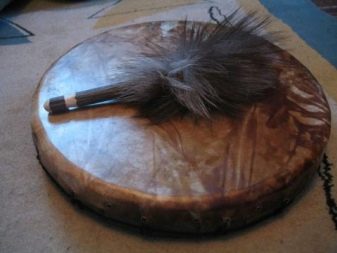What is a tambourine and how to play it?

When they mention a tambourine, most people think of it in context with a shaman. At the same time, the percussion instrument is famous not only for this relationship. The tambourine gained popularity all over the world for surprisingly decorating the music of different nations with its sound. Many national dances are accompanied by a tambourine accompaniment.



What it is?
The tambourine does not differ in its complex structure and looks like a half-drum. The musical instrument is arranged as follows: a leather membrane is stretched over a wooden or metal rim-shell - the main sound source. From 6 to 8 holes are cut in the rim, in which paired metal plates are installed on stationary pins or on a wire - copies of miniature orchestral plates.
Some types of tambourines have additional voiced components in the form of bells or bells. They are attached to a wire in the tool body.
The tambourine has long been used for rhythmic accompaniment to dances and chants. Many peoples of Central Asia are actively passionate about solo playing on it. Despite the fact that a tambourine is considered a simple percussion instrument, its range of applications is quite versatile. First of all, it should be noted that it is widely used in the creation of ethnic music and accompanies the witchcraft rituals of shamans. In addition, the tambourine participates on an equal footing in all kinds of ensembles of different directions, including symphony orchestras. Only its body is made of metal, and the membrane is made of plastic. The instrument has taken root in youth circles, especially among hipsters, and plays a significant role in teaching musical literacy.

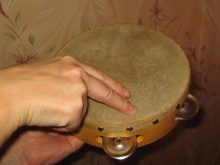

Instrument history
Now it is difficult to accurately answer the question of how many centuries have passed since the birth of the first tambourine. Perhaps it appeared at a time when ancient people began to make clothes for themselves from animal skins. The finished skins were stretched over a wooden frame to dry, and the tambourine is similarly constructed. Someone from the primitives could well have shown ingenuity and come up with an instrument for creating sounds.
It is known for certain that the mysterious shamans in the ancient tribes accompanied ritual dances and guttural singing by playing the tambourine. It was a must at any gathering important to the tribe (wedding, commemoration, hunting, etc.).
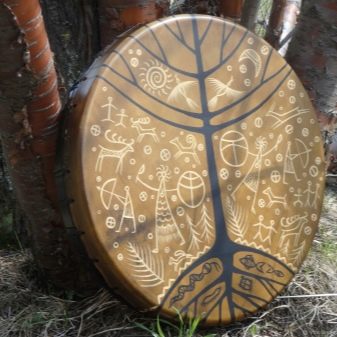

The world has known the instruments that are prototypes of the tambourine since antiquity. For example, the ancient tympanum, widely used by the ancient Greeks in the 5th century BC. NS. The one-sided drum arrived in Greece after it found fans in Thrace and, along with the glorification of Dionysus and Cybele, quickly became popular. Tympanum was mentioned in the opuses of the playwrights Euripides and Athenaeus, and drawings depicting the instrument adorned antique dishes.
An instrument similar to the tympanum was used in the Middle East during the Old Testament. This is confirmed by the preserved ancient writings. Among the Jews, it was a frame drum - a folk instrument tof that sounded during religious rituals and important ceremonies.
According to one version, the appearance of a tambourine in Asia dates back to the Bronze Age. The instrument gained much more popularity when it found itself in the Middle East and later in Europe, reaching the British Isles and the lands of Northern Ireland. In the 18th century, the "competition" of the tambourine was a cylindrical tambourine, which later became the prototype of the currently existing drums. The tambourine was invented by French sheep-dogs, accompanying playing the flute on it. It was distinguished from the usual tambourine by the width of the rim and the softened sound. Instead of hands, special sticks were used for the game.

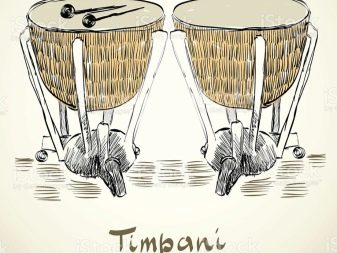
In the future, the tambourine underwent constructive changes: it lost its leather membrane, there were only undisguised ringing elements and the rim itself.
In Russia, they learned about the tambourine even in archaic times, when people united into tribes and believed in pagan deities. In Slavic life, instruments were given great importance. All important events were accompanied by the sound of a tambourine.
The most reliable materials about the history of the tambourine in Russia were obtained by historians from archives dated to the 10th century A.D. e., in the description of the military campaigns of the squads of the faithful Russian prince Svyatoslav Igorevich.
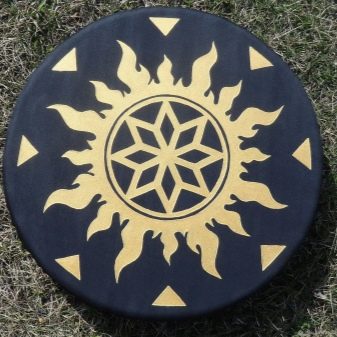

At that time, it was customary to call any drum with a leather membrane a tambourine. The Russian people especially revered the majestic battle tambourines. In large-scale military tasks, a special purpose was determined for them: the creation of sound communication between the troops, and also an ominous roar drove the enemy into a panic state.
Large-sized military drums were transported on 4 horses. These were massive metal vessels covered with leather material. Dimensional tambourines were called alarm bells or tulumbases. The sound was extracted from them by 4-8 alarms with special beaters made of horse whips with a wooden handle at one end and a leather-braided ball at the other. Every voivode had a war tambourine, and the army was numbered by their number.
A little later, the tambourine was widely used in Russia by guide bears. The instrument of that time bears more resemblance to its modern counterpart: a small wooden shell covered with leather with bells inside. The Russian people enthusiastically watched the bear fun. In the course of the spectacular action, the bear bowed to the audience, marched cheerfully, depicted a struggle with its master and danced, standing on its hind legs, holding a tambourine in its front limbs.
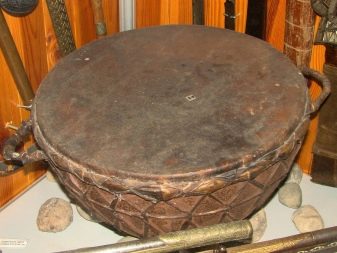

In those days, tambourines were a popular instrument among buffoons, entertaining people with amusing performances. The buffoons traditionally participated in wedding and memorial acts, possessed knowledge of the pagan magi, could heal and divine for the future. Church ministers and rulers were alarmed by the activities of buffoons, so the latter were persecuted, and tambourines were declared demonic instruments. At the height of the 17th century, the princely decree of Alexei Mikhailovich ordered the destruction of buffoons and all their tools. That period caused tangible damage to the development of the national Russian musical art.
Most often, the tambourine was used in ritual practice. With the help of this tool, it was possible to enter a person into a state of trance. This was facilitated by the sound of repetitive beats performed in a verified rhythm. In this case, the constancy of the rhythmic pattern did not matter; it could change, including in terms of the volume level. The sound of the tambourine "rocked" the consciousness of the sage performing the ritual dance. The special state allowed the shaman to contact the spirits.
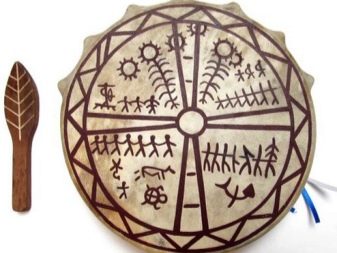

The traditional ritual shaman's tambourine is made using cow or lamb skin. It was pulled with leather cords, which were fastened on the seamy side of the tambourine with a metal ring. The owner of the instrument considered it to be his personal thing, which no one was allowed to touch. Each witch was personally engaged in the manufacture of his tambourine. Before starting the creation of the instrument, it was necessary to endure a certain fast. At this time, the shaman had to streamline his train of thought, getting rid of unnecessary thoughts. Fasting also meant a temporary rejection of physical pleasures. Only after the total fulfillment of all these points, the shaman could start making his ritual instrument.
During his life, a shaman could wield several tambourines. Usually there were up to 9 of them. When the skin on the last tambourine was torn, it means that the priest's life was nearing the end, he was to die.
It is important to note that no one was allowed to encroach on his life at the time. Usually the shaman left the world of the living by himself, without violence, in a natural way.

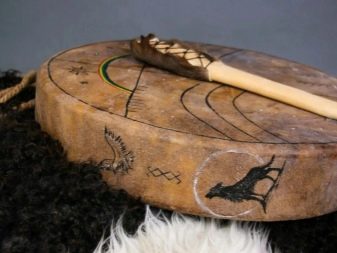
According to tradition, the shaman never possessed several tambourines at the same time. But this unspoken charter had exceptions, for example, when the witch needed to create a separate instrument for a certain ritual (after the ritual it was destroyed), or when the witch created an additional tool together with the governor.
The shaman's instrument was decorated with certain drawings. They had a lot of meaning and symbolic load. These were small schematic drawings. In addition to the shaman himself, a picture of the world was applied to the skin. There were other ritual drawings on the membranes - the spirits of the shaman, his totem, and so on.
Sometimes the pattern adorned only the front side of the membrane, less often the inner side, where a cruciform handle or a bar fixed in an arbitrary order was located. On some products, instead of a handle, a metal ring or an untreated leather loop was attached. Before installing the handle, sometimes a spiral symbol was previously applied in this place.


Choosing wood for the sides, the shaman consulted with his spirits, shared his thoughts on which tambourine he wanted to assemble, what kind of travel he was planning. Such conversations took place in the form of individual or mass meditation. In search of a tree for the rim, the shaman followed the call of the spirit. When he was determined with the place where the desired tree grew, he closed his eyes, went into a trance, calling out to his spirit.
With a similar thoughtfulness, intuitively, an animal was selected, the skin of which was turned into a singing part of a shaman tambourine.


The ancient people considered the inextricable connection of the sorcerer's life force with his ritual instrument. When a shaman was dying, he was considered irrevocably gone into the world of the dead. Therefore, his tambourine was supposed to be destroyed, killed, releasing all spirits, turning a mystical object into an ordinary one.The membrane of the tambourine was pierced on the branches of a tree growing at the shaman's grave: this is how they marked the burial, which was not only forbidden to disturb, it was not even worth approaching here without urgent need.
If the last refuge of the shaman did not look like a mound or burial ground, but, for example, like a yurt, the tambourine was left hanging at the entrance, signaling that the shaman was reposed there. Less often, the tool was left near the chimney. Traditionally, the membrane was pierced, rendering the tambourine unusable.
Sometimes in the legends there are references to how a wanderer came across a "devastated" village and inadvertently disturbed the spirit of the deceased shaman.
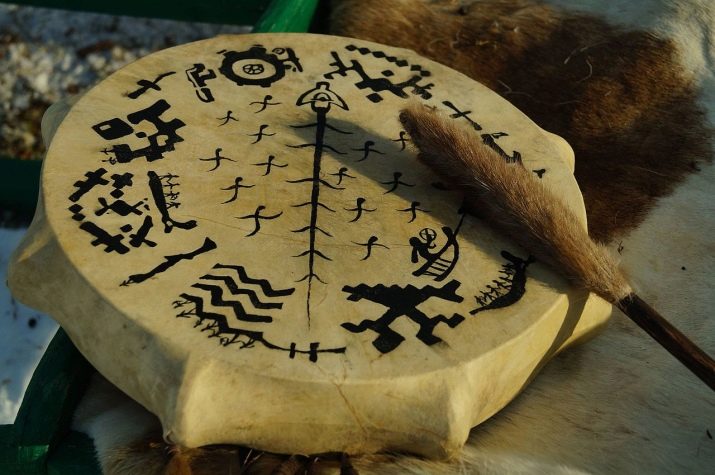
Sound
The tambourine is a percussion musical instrument that demonstrates an indefinite pitch. The rhythmic pattern performed on it is recorded in one line. The instrument is distinguished by a special timbre color, imparted by the rattling of metal elements suspended from the body. Drum claps, coupled with the chime of bells, sound quite distinctive.
The rhythms accompanying the sacred ritual are considered sacred in the tribes. There are 8 basic rhythms in total. According to the chakras of the person. They are written as dots, from bottom to top. One point defines a single blow, two means two knocks in a row. All rhythms have a hidden meaning and special purpose. The rhythm of shamans does not just dress in sounds, but bears the names of animals: bear, fox, hare and others.
Each type of tambourine emits its own unique sound, from which music is born.

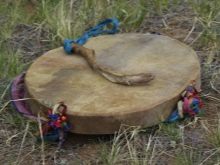

Views
The classic wooden tambourine is one of the most common instruments. Its varieties are found in different parts of the world and have certain distinctive characteristics. There are one-sided tambourines and modifications without a membrane.
Gaval
The eastern tambourine is known in its area as daf or doira. The diameter is average among instruments of this type, ranging from 35-46 cm. The membrane is made of sturgeon skin. The sound is extracted from the instrument by tapping with fingers or claps of the palm.
Instead of pendants, they use not bells, but metal rings, numbering 70 pieces.
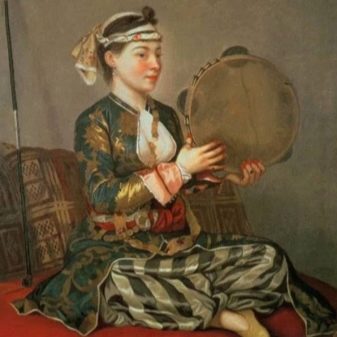
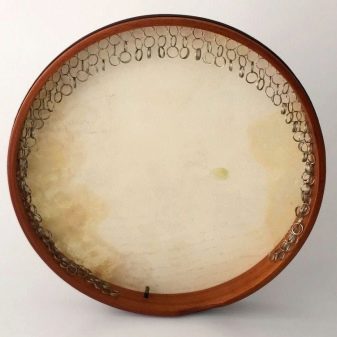
Kanjira
Indian type of tambourine, which differs from analogs in a higher voice. The tool is quite small in diameter, from 17 to 22 cm. The design is simple but sophisticated: a lizard leather membrane on the rim with a pair of small ringing discs.
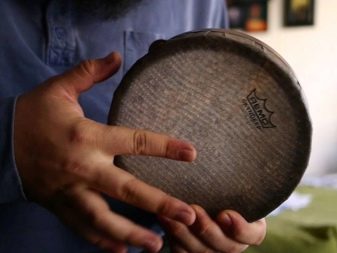
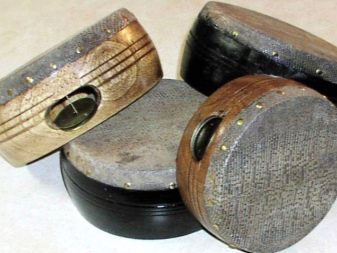
Boyran
A large Irish tambourine, up to 60 cm in diameter, while the shells are from 9 to 20 cm deep. On such an instrument, the sound is born from the blows of a one-sided or double-sided beater.
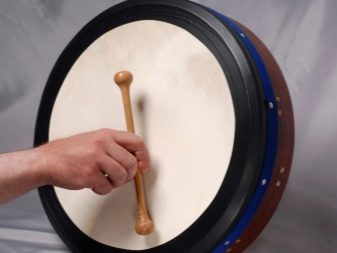
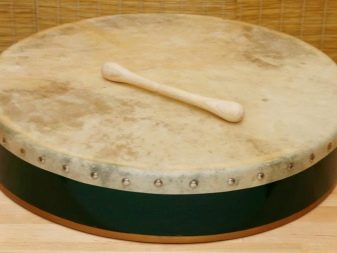
Pandeiro
An instrument that has become very popular among the Portuguese and South Americans. Brazilians consider him to be the soul of incendiary samba.
Unlike other drums of this type, the pandeira can be tuned.
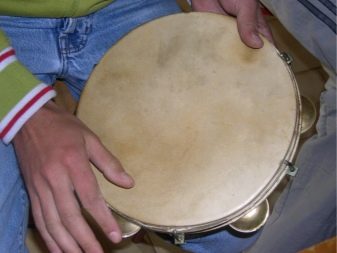
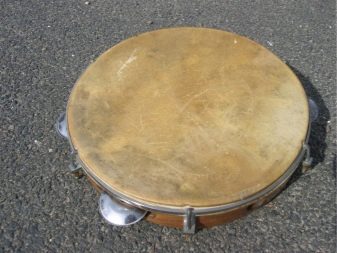
Tungur
The shaman tambourine is known under this name in Altai and Yakutia. Oval or round leather-wrapped rim. It is equipped with a vertical handle to hold a heavy tool from the inside. There are also rods that hold a number of metal suspension elements. Often the leather membrane of a ritual drum is decorated with a drawing - the Tree of the Universe with a map of the world.
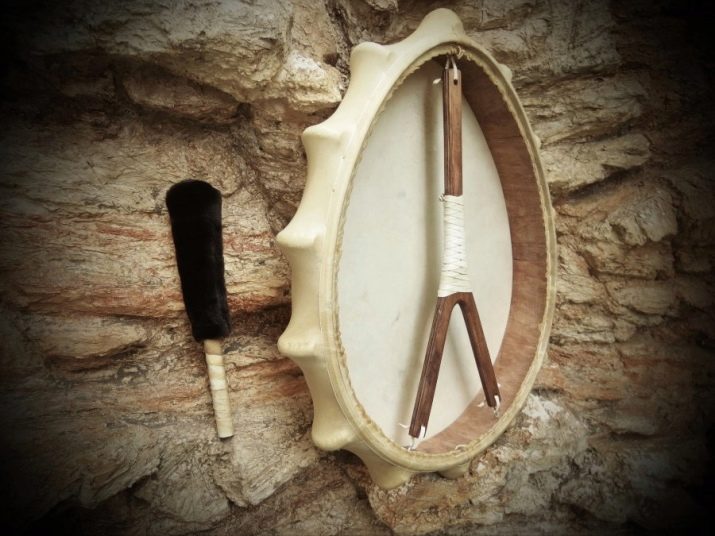
Technique of the game
Many people mistakenly think that the tambourine is a rather primitive instrument, the playing of which does not require special experience and virtuosity. This is not entirely correct, since it is not enough just to shake or bang the tambourine. The performer must be endowed with an ear for music and feel the rhythm, be able to masterfully handle the instrument. Usually a tambourine is taken in the left hand, and the right one performs rhythmic beats, but many performers act the other way around. Their right hand remains motionless, and it is the tambourine that is used, which turns out to be much more melodic and graceful, although it is more difficult to perform.
There are many tambourine playing techniques, but there are only three leading ones: not too sharp single claps, shaking, tremolo.The musician produces sound using the phalanges of the fingers of either hand.

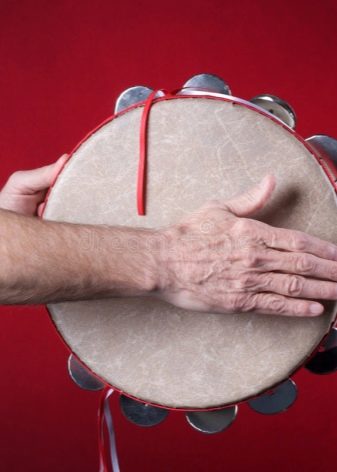
Shaking - consists of almost convulsive claps in the elbow area or on the wrist with a tambourine. At the same time, only the pendants sound.
Tremolo - vigorously shaking the rim with one hand.
Virtuoso tambourine players put on real performances and unique sound shows. Like circus performers, they throw up their instrument and then catch it on the fly. Then they hit the rim on their knees and head, use the chin and the rest of the body, including the nose. They tremolize effectively, they can even make the tambourine make a sound like a howl.


Interesting Facts
During the reform of the Russian churches, the Moscow Patriarch Nikon ordered to destroy the musical instruments of the buffoons. Five carts loaded to the top, where there were many tambourines, arrived at the Moscow River. The cargo was publicly burned at the stake, which had been blazing for more than one day.
A tambourine for shamans is not just an important tool, but is endowed with many meanings. He can appear to the owner as a horse, on which he moves around the heavenly world, as a boat carrying through the waters of underground rivers, as an instrument against evil spells.
It has been documented and proven by ongoing research that with the help of tambourine sounds emitted in a verified rhythm, shamans are able to introduce a person into a state of light trance and even hypnotize.


The shaman's tambourine is considered a sacred thing, touching which is forbidden for everyone except the owner. He must even create his own instrument without anyone's help, after a series of rituals and actions aimed at bodily and spiritual cleansing.
The rite always begins with the purification of the instrument, that is, with its "revitalization" by warming it over the fire. After that, with claps on the membrane and a guttural chant, the sage calls out to the spirits, which, according to age-old beliefs, arrive and are embodied in the pendants of a tambourine.

It is believed that the sound of a tambourine has a beneficial effect on the thinking and subtle energy structures of a person. The sound emanating from the ring-shaped rim with the leather membrane helps to immerse oneself in the state of what is known as altered consciousness. From sound vibrations, concentration increases, emotions are cleared, harmony is felt and the psychological state is normalized.
Handmade shaman tambourines are bought by collectors from all over the world. These are unique piece pieces with their own special aura and historical past.
The tambourine is an original musical instrument with a long and entertaining history. Today, as before, it is considered the main attribute of shamans, but it finds successful application in the field of folk art and in various modern genres. Its sound is able to charge you with optimism, improve the sound of melodies, adding amazing shades to them.
